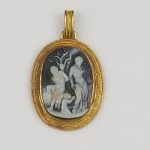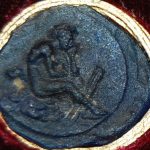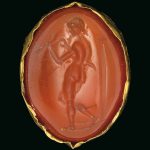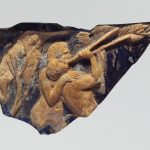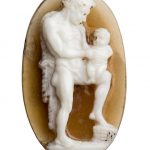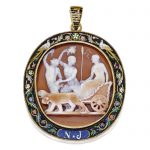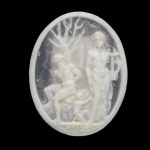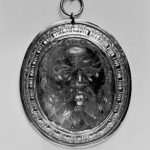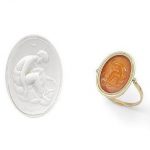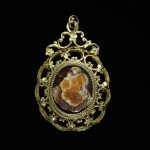In Greek mythology, satyrs are deities of the woods and mountains. They are half-human and half-beast; they usually have a goat’s tail, flanks and hooves. Satyrs can come in other hybrid human/animal forms, as well. According to William Hansen, “Satyrs are two-legged beings having the lower body of a horse and the upper body of a man.” Satyrs emit of hoarse sound, a mix of the neighing of a horse and the bleating of a goat.
In Greek art the satyrs were represented as a man with horse’s ears and tail. However in Roman representations they are portrayed as having the upper body of a man with a goat’s ears, tail, legs and horns. Reference: Wikipedia
According to Myths and Legends of Greece and Rome, by E M Berens, satyrs were grotesque and repulsive with flat broad noses, pointed ears, and little horns sprouting from their foreheads, a rough shaggy skin and small goats tails.
A carved hardstone cameo pendant Carved to depict the flaying of Marsyas, in ropetwist detailed mount, on similary decorated bale, length including bale, 3.6cm. FOOTNOTES Marsyas was a satyr and an expert pipe player. He challenged to god Apollo to a musical contest. Apollo, the god of music, won the contest. The prize Apollo exacted was to have Marsyas tied to a tall tree and flayed alive.
Sold for £1,527 inc. premium at Bonhams in 2006
Cameo of transparent blue glass paste, engraved with a youthful satyr seated on a rock with his head on his hand; between his legs are double-flutes. Culture/period: Roman Imperial (early) term details Date 1st – 2nd Century
Reference: © The Trustees of the British Museum
AN ITALIC CARNELIAN RING STONE WITH A SATYR CIRCA 2ND-1ST CENTURY B.C. 22 mm. long
Sold for GBP 2,000 at Christies in 2018
Glass cameo cup (scyphus) fragment Period: Early Imperial, Augustan or Julio-Claudian Date: late 1st century B.C.–mid-1st century A.D.
Translucent cobalt blue with opaque white overlay; handle in translucent cobalt blue. Slightly everted rim tapering to rounded vertical lip; convex curving side; part of right side of handle attachment overlaid on white with small pointed projection. On exterior, in deep relief two satyrs, naked from hips and waist, the one to right with his right arm around shoulder of the other, who is leaning back and playing the double flute, held aloft by both his hands; to either side of satyrs branches of pine trees. Broken with weathered edges; pitting of surface bubbles, dulling, and creamy weathering with iridescence.
Reference: The Metropolitan Museum of Art
Cameo with satyr and infant Italian Renaissance Period 15th century
White over golden brown sardonyx cameo. Satyr with animal skin over shoulders and left foot raised on a syrinx (panpipes) in three-quarter view to right, balancing on his knee an infant holding a syrinx. Ground line. Cracked at left.
Reference: Museum of Fine Arts Boston
Silver-Gilt, Gold, Carved Shell Cameo, Micromosaic and Seed Pearl Pendant, Nicolo Morelli, Early 19th Century Centering an oval carved shell cameo featuring a Bacchanalian procession with a woman seated in a chariot drawn by two panthers accompanied by a male reveler drinking from a wine skin and a satyr brandishing clusters of grapes, signed N. Morelli, the surrounding frame of silver-gilt inlaid with a micromosaic of scrolling foliate motif with the initials N J below, probably for Napoleon and Josephine, and flanking doves towards the top of the frame, the gold pendant loop of later date with the letter ‘J’ accented by small seed pearls. With fitted box.
Sold for 34,375 USD at Sothebys in 2010
Shell cameo of the flaying of Marsyas by Apollo, Italian, ca. 1650-1670
The satyr Marsyas was a skilled flute-player who was forced into a musical contest with the god Apollo. Unfortunately, he used a flute that had been cursed and discarded by the goddess Minerva. Apollo won the contest and ordered Marsyas to be tied to a pine tree and flayed alive.
Reference: © Victoria and Albert Museum
Cameo with a Bearded Satyr
ca. 1550-1575 (Renaissance)
Reference: The Walter Art Museum
